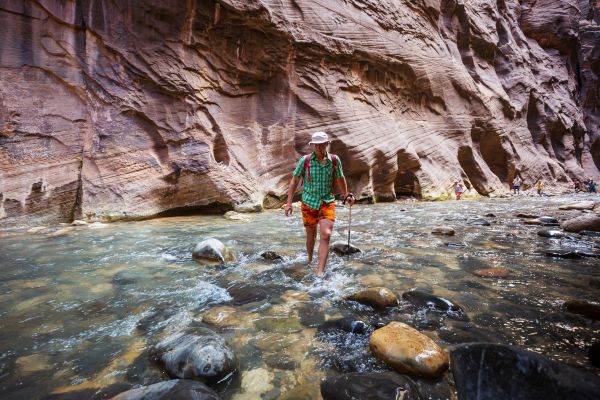Don’t Freak Out! How to Pee in Zion National Park
Posted by Krista Eickmann on 10th Jun 2024
Zion National Park is unforgettable. Its broad, green river canyon, flanked by towering 2,600-foot red rock walls, is like a natural cathedral. The hikes—like the famous walk up to Angel’s Landing or up the Zion Narrows—are the experience of a lifetime.
Hiking in the arid southwest, however, is different. Zion’s hikes are demanding, and most visitors come in the summer months when staying hydrated is especially important. You’ll want to think ahead about where and how you’ll pee.

The Zion Narrows
The Virgin River originates north of Zion National Park in Utah and flows southwest to become a tributary of the Colorado. As the river enters the park, it is already carving the gorge that becomes the Narrows, a passageway that is 1,300 feet deep at its height and only twenty to thirty feet wide.
“At least 60% of the hike is spent wading, walking, and sometimes swimming in the river,” advises the park service, making this hike unusual, refreshing, and undoubtedly challenging for those undertaking it.
The river gorge’s incredibly high, close walls make the Narrows of Zion National Park an experience you won’t forget. One section of the gorge is known as “Wall Street,” after lower Manhattan’s canyon-like streets.
The Hikes
There are several ways to hike into the Narrows. Starting at the south end, the first mile is a paved, wheelchair-accessible path known as the Riverside Walk. Past the end of the pavement, walking in the river is unavoidable.
Day Trip 9 Miles
Most people do an up-and-back day hike from the south end to Big Spring, a little over 9 miles round trip. No permit is required, and the hike begins at a park bus stop.
Overnight 16 Miles
You’ll need a Zion National Park map for the next option. A sixteen-mile through-hike of the Narrows starts far upstream, on the relatively open ground at Chamberlain’s Ranch. Wilderness permits are required for this hike.
Ambitious hikers can complete the through-hike in a single day, but the real pleasure is camping overnight in the gorge at selected sites above Big Spring.
The pStyle
The pStyle is a handheld, rigid-plastic funnel that lets youpee standing up even when you’re fully clothed. It is commonly known as a stand-to-pee device.
The pStyle is usefulanywhere you take it. Bathrooms can be surprisingly hard to find, no matter where you are, and there’s no guarantee the toilets are clean enough to sit down on. Imagine the toilets in a busy national park campground in July.
In rural areas, using a pStyle lets you pee just about anywhere. It’s easy to be discreet when all you have to do is turn your back, and it’s much easier to avoid ticks and poison ivy.
Leave No Trace
The pStyle is the eleventh essential for any National Park vacation, especially at Zion. Zion National Park hikes are mostly in arid terrain—more on that below—but the Narrows presents particular challenges for peeing and pooping.
LNT In the Narrows
The park service asks hikers in the Narrows to pee directly into the river. Dried urine on the river’s edge can persist for months, but “the solution to pollution is dilution.”
In the Narrows, finding enough privacy to drop your shorts is nearly impossible, especially if you’re aiming for the water. The pStyle changes all that: turn your back, unzip your fly, and pee into the river. Hikers must carry out poop in toilet bags.
LNT in Arid Areas
Many other Zion National Park trails are in more arid locations where bathroom etiquette differs from that of the Narrows.
Heavy visitor traffic has led to more strain on the park as people venture off trails and damage sensitive ecosystems. For this reason, the park is metering hikers on Angel’s Landing and holding a lottery for permits.
Bathrooms in central Zion Canyon locations help lessen the human impact of thousands of hikers each year on popular trails. Nonetheless, sometimes you’ll have to go when you’re on the trail.
STP and LNT!
Stand-to-pee devices have a role to play in responsible stewardship of sensitive ecosystems. A person who can confidently decide when and where to pee can also make responsible ecological decisions.
“Leave No Trace” is an easily understood set of ethics for lessening the impact on the outdoors. In arid places, urine odor near waterways can deter wildlife from accessing their water sources. That’s why it’s important to pee away from riverbanks and water sources.
In arid climates, your pee can hang around for a while. The Zion National Park weather pattern calls for less than15 inches of rain annually, so try to pee on rocks, not plants: “Salt-deprived animals have been known to defoliate plants to consume the salt in human urine.”
Racist History of the National Parks
It’s advisable to educate yourself about the violent history of the national park system before visiting.
If you’re looking for things to do in Zion National Park or any other national park in the United States, reading up on this history will deepen your understanding of the parks and how they have an impact on all Americans today.
Books like Dispossessing the Wilderness: Indian Removal and the Making of the National Parks by Mark David Spence puts the parks past and present into perspective.
Returning control of the park system to Indigenous people may well be the key to preserving these extraordinary places for future generations.
Everything Is Possible
Zion National Park is a precious and wonderful place. If you choose to visit, be prepared to sustainably handle your waste and leave no trace!
Heading to the Narrows this summer? Check out our website for more information about the pStyle.
We carry a full line of pStyles and the organic cotton pCase. Questions? Ask us on our contact page!


